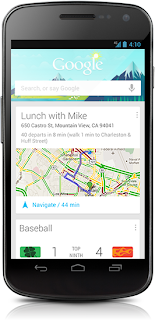Android Jelly Bean 4.1
Google unveiled Android 4.1, the latest version of its mobile operating system, code-named Jelly Bean, at the annual Google I/O developers’ conference. Jelly Bean is an incremental update, with the primary aim of improving the user interface, both in terms of functionality and performance. The performance improvement involves "Project Butter", which uses touch anticipation, very responsive screen, triple buffering, extended vsync timing and a fixed frame rate of 60 fps to create a fluid and "buttery"-smooth UI. Android 4.1 Jelly Bean was released to AOSP on July 9, 2012.
Due to the success of Google’s “Project Butter”, the latest version of Android is just like the saying goes “as smooth as butter”. Jelly Bean is the most responsive and impressive version of Android to date coming with triple buffered graphics, extended vsync timing and intuitive touch that boosts your CPU at the next touch event to make sure lag is minimal.
Enhanced Accessibility
Jelly Bean includes new API’s for accessibility features such as services that let you handle gestures and manage accessibility focus with on-screen navigation buttons. These can be handled by accessibility gestures, accessories, or other input methods. Applications that use the standard View components inherit support for these new features automatically without the need for developers to alter their code.
Android 4.1 brings a major update to Android notifications. Apps can now display larger, richer notifications to users that can be expanded and collapsed with a pinch. Notifications support new types of content, including photos, have configurable priority, and can even include multiple actions assigned to them.
Resizeable App Widgets
Android 4.1 introduces improved App Widget functionality that can automatically resize, based on where the user drops them on the home screen, depending on the size, and the amount home screen real estate available. You can also supply separate landscape and portrait layouts for your widgets, which the system activates depending on your current screen rotation.
High Resolution Contact Photos
With Android 4.1, we cab finally store our contact photos at a whopping 720 x 720, allowing contact pictures to be truly beautiful. Apps can store and retrieve contact photos at that size or use any other size as needed.
Android Beam
 Android Beam was introduced with ICS, but we haven’t seen a lot of uses for it. In Android 4.1, Android Beam makes it easier to share images, videos, or other payloads by leveraging Bluetooth for the data transfer. When the user triggers a transfer, Android Beam hands over from NFC to Bluetooth, making it easier to transfer and manage files between devices.
Android Beam was introduced with ICS, but we haven’t seen a lot of uses for it. In Android 4.1, Android Beam makes it easier to share images, videos, or other payloads by leveraging Bluetooth for the data transfer. When the user triggers a transfer, Android Beam hands over from NFC to Bluetooth, making it easier to transfer and manage files between devices.
Smart App Updates
The latest feature of Google Play introduces a better way to receive application updates on your devices. When a developer publishes an app update, Google Play now only delivers the changes bits of the application rather then the entire APK. This makes app updates much lighter and easier on your network data. On average, a smart app update is about 1/3 the size of the full APK update.
Android 4.1 helps developers reach more users through support for bi-directional text. Apps can handle text editing in left to right or right to left scripts. Apps can also make sure of new included Arabic and Hebrew locales and fonts. If that isn’t enough, the platform now supports user-installable keymaps.
Google Voice Search and Google Now
Google has drastically improved the default Voice Search functionality with Android 4.1. Dubbed Google Now, the new search functionality makes search much more visual such as displaying your results as cards for weather, navigation routes, sports scores, and more. This is much more than a virtual assistant.
Jelly Bean 4.1 changes:
- Vsync timing across all drawing and animation done by the Android framework, including application rendering, touch events, screen composition and display refresh
- Triple buffering in the graphics pipeline
- Enhanced accessibility
- Bi-directional text and other language support
- User-installable keyboard maps
- Expandable notifications
- Ability to turn off notifications on an app specific basis
- Shortcuts and widgets can automatically be re-arranged or re-sized to allow new items to fit on home screens.
- Bluetooth data transfer for Android Beam
- Offline voice dictation
- New interface layout for tablets with smaller screens (closer resembling that of a phone)
- Improved voice search
- Improved camera app
- High resolution contact photos
- Google Now
- Multichannel audio
- USB Audio (for external sound DACs)
- Audio chaining (also known as gapless playback)








![Adults Use of Internet [Study]](https://blogger.googleusercontent.com/img/b/R29vZ2xl/AVvXsEhLP8kgrb7qchcisx8y-mjiMsCIdAVJ1C9g7VEvz5esUn3rPqiDtf9W8d0PnoFu6tOGxMEAPlpSpVb6F_4eJf00nvCHcLTQ3b_fo6d0270n8Yg-zuMqWi_vMNNtbu8BbUgJ2sPqDzMUip4/w72-h72-p-k-no-nu/checkingemail.jpg)
Thanx Christin..
ReplyDeletekeep visiting...